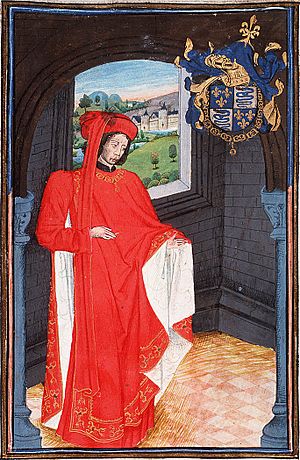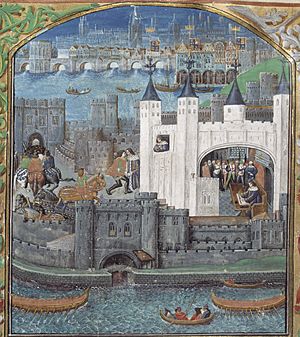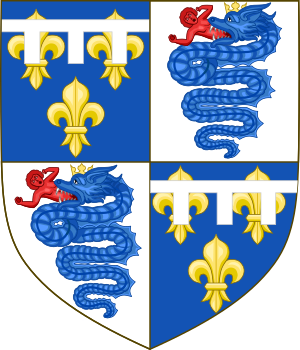Charles, Duke of Orléans facts for kids
Quick facts for kids Charles |
|
|---|---|
 |
|
| Duke of Orléans | |
| Tenure | 23 November 1407 - 5 January 1465 |
| Predecessor | Louis I |
| Successor | Louis II |
| Born | 24 November 1394 Paris, France |
| Died | 5 January 1465 (aged 70) Amboise |
| Burial | Saint Denis Basilica, France |
| Spouse |
Bonne d'Armagnac
(m. 1410; died 1435) |
| Issue | Joan, Duchess of Alençon Marie, Viscountess of Narbonne Louis XII of France Anne, Abbess of Fontevraud |
| House | Valois-Orléans |
| Father | Louis I, Duke of Orléans |
| Mother | Valentina Visconti |

Charles of Orléans (born 1394, died 1465) was a French nobleman. He became the Duke of Orléans in 1407 after his father was killed. He also held other important titles like Duke of Valois and Count of Blois.
Today, he is best known as a talented poet from the Middle Ages. He wrote over 500 poems in both French and English. Many of these poems were written during the 25 years he spent as a prisoner of war.
Contents
Becoming Duke
Charles was born in Paris in 1394. His father was Louis I, Duke of Orléans, and his mother was Valentina Visconti. He became Duke when he was just 13 years old. This happened after his father was killed by order of John the Fearless, the Duke of Burgundy.
Charles was expected to lead his family against the Burgundians. This was a powerful group in France that supported the Duke of Burgundy. John the Fearless was never punished for his role in Louis's death. Charles's mother, Valentina, became very sad and passed away soon after.
In his early years as Duke, Charles was guided by his father-in-law, Bernard VII, Count of Armagnac. Because of this, Charles's group became known as the Armagnacs.
Even before his father's death, Charles received money from his uncle, King Charles VI. His first marriage to Isabella of Valois also brought him a large sum of money.
Captured in War
In 1415, war started again with England. Charles was one of many French nobles who fought in the Battle of Agincourt. On October 25, 1415, he was found unharmed but stuck under many bodies. The English took him prisoner. He would spend the next 24 years as their captive.
During his time as a prisoner, Charles was moved between different castles in England. These included the Tower of London and Pontefract Castle. The conditions of his captivity were not harsh. He was allowed to live much like he was used to.
However, the English king, Henry V, did not want to release him for ransom. Charles was a very important leader of the Armagnac group. He was also in line to become the French king. So, he was considered too important to let go.
Charles the Poet
It was during these 24 years that Charles wrote most of his poems. Some of his sad poems seem to be about being held captive.
Most of his writings are in two books, one in French and one in English. They are written in special poetry styles called ballade and rondeau. It is now clear that Charles wrote the English poems himself.
Some of his poems have been turned into music. For example, Edward Elgar set one of his poems, Is she not passing fair?, to music. Claude Debussy also used three of his poems for a choir piece.
Freedom and Later Life
Charles was finally set free on November 3, 1440. His former enemies, Philip the Good and Isabella of Portugal, the Duke and Duchess of Burgundy, helped him. He returned to France after 25 years. He was 46 years old and, according to one English writer, "speaking better English than French."
Part of the agreement for his release was a large payment. Philip the Good also made Charles promise not to seek revenge for his father's death. Philip's own father had killed Charles's father. Charles agreed to this before he was released.
When he met the Duchess of Burgundy after landing in France, Charles politely said, "My Lady, I make myself your prisoner." At the celebration of his third marriage, he was made a Knight of the Golden Fleece. His return to Orléans was celebrated by the people.
Charles tried to claim land in Italy but was not successful. He then settled down and became a famous supporter of the arts. At his home in Blois, he had a small court. Many French writers of the time, like François Villon, visited or wrote to him. He passed away in Amboise when he was 70 years old.
Family Life
Charles married three times. His first marriage was in 1406 to his cousin, Isabella of Valois. She was the daughter of Charles VI of France. Isabella died three years later during childbirth at age 19. Their daughter, Joan, survived but later died without children.
Secondly, Charles married Bonne of Armagnac in 1410. Bonne died before he returned from being a prisoner. They did not have any children together.
When he returned to France in 1440, Charles married Marie of Cleves. She was the niece of Philip the Good, who had helped free him. They had three children:
- Marie of Orléans (born 1457, died 1493). She married Jean of Foix.
- Louis XII of France (born 1462, died 1515). He later became King of France.
- Anne of Orléans (born 1464, died 1491). She became an abbess, a leader in a convent.
Honors and Recognition
 Kingdom of France – Duchy of Orléans : Grand Master and Knight of the Order of the Porcupine
Kingdom of France – Duchy of Orléans : Grand Master and Knight of the Order of the Porcupine Duchy of Burgundy : Knight of the Order of the Golden Fleece
Duchy of Burgundy : Knight of the Order of the Golden Fleece
In Books and TV
- Charles appears as "Duke of Orléans" in William Shakespeare's play Henry V.
- He is a main character in the historical novel In a Dark Wood Wandering by Hella Haasse. This book tells his life story in a kind way.
- Charles is also a character in Margaret Frazer's book The Maiden's Tale. This story is a mystery about a few weeks of his life in England.
- He is mentioned in the Netflix show Big Mouth as the author of "the first known Valentine."
See also
 In Spanish: Carlos I de Orleans para niños
In Spanish: Carlos I de Orleans para niños


